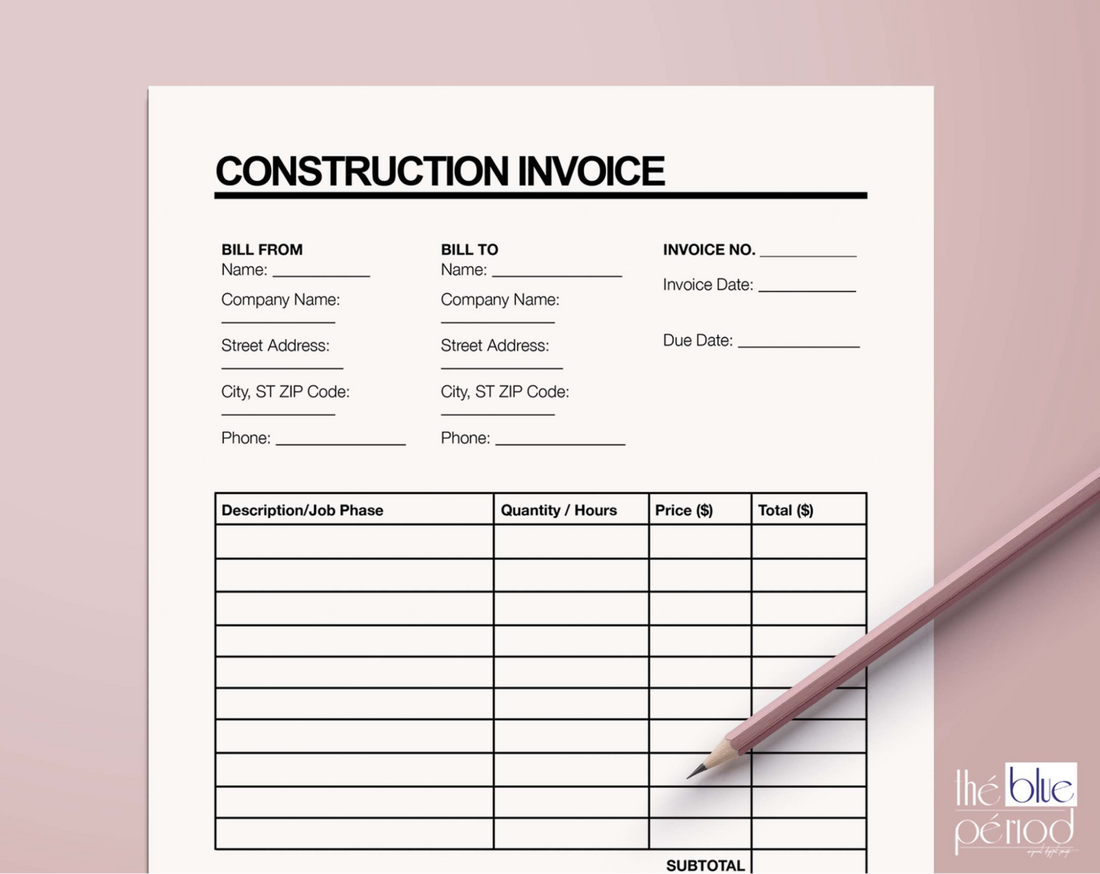
Building a Construction Invoice Template Using Simple Steps
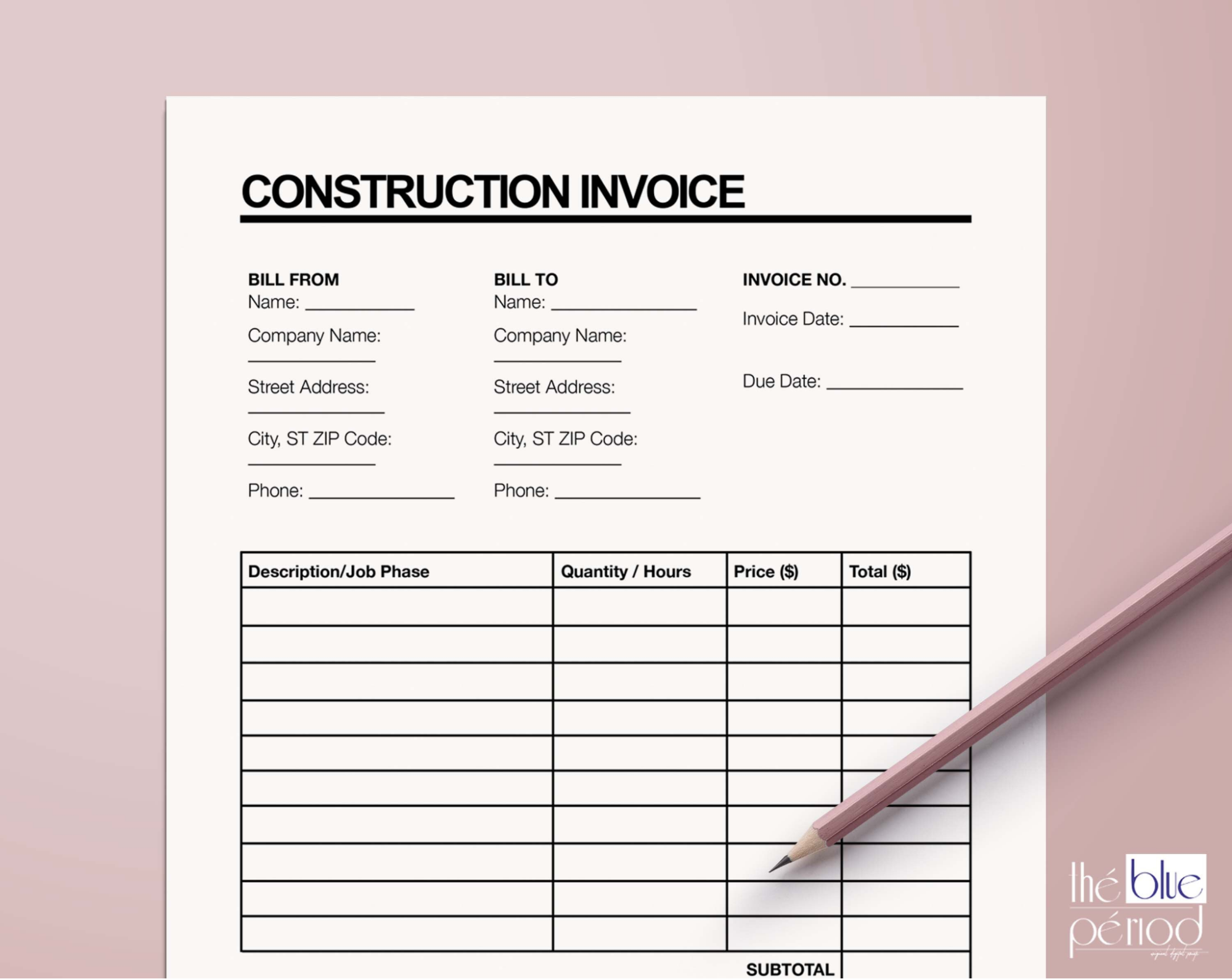
A construction project can become a headache for the project manager, especially considering all the aspects they must worry about, like the payment process and labor costs.
For this, the construction industry uses a document called the construction invoice. It can be used for all kinds of construction jobs, regardless of size and complexity.
For it to work properly, you must choose the right categories and build a template that truly reflects your needs. In this article, we will show you how to create professional invoices that will help with the billing process and any other task your construction projects might have. Follow each step to ensure an effective document that enables you to reach your goals most effectively.
But before we see what should be featured in the construction invoice form, we need to review some basic concepts, like what this document is and why it is crucial. If you don’t know, don’t worry. We got you covered.
Building a Construction Invoice Template Using Simple Steps
What Are Construction Invoice Templates
These invoices are documents created specifically for construction businesses to better manage payments, whether from team members or material costs. The document helps construction business owners to track how much was paid, to whom, and when.
Creating these templates is a standard in construction companies and, if done properly, can avoid numerous problems and mistakes during and after the project’s conclusion.
These invoices can also be used to present proposals of anticipated project costs and payment options. The document contains numerous data that can be valuable for the works and construction owner.
Why Construction Invoicing Is Important
More than just tracking how much each step costs, there are numerous factors that make the construction invoice an indispensable tool. The first is to ensure both parties agree on the due date and payment method stipulated for each item.
It is also important to present an initial projection on the project cost and completion time. This way, you can keep the team and all relevant stakeholders on the same page.
Moreover, in case any payment is not made as requested, the document can be used as proof if any legal action is necessary. It will register numerous aspects of the project and serve as a reference whenever it needs to be consulted.
Construction Invoice x Receipt

Many people might get confused about the difference between the construction invoice template and a receipt for the job done. Here is a simple explanation of the differences between them and when to use each one:
Construction Invoice Template
As previously mentioned, the invoice template for a construction business is a document used to get payment from the customer that contracted your services. It is a document handed to the customer before receiving the payment and will feature all relevant information, like the price of each service and the due date for paying.
The invoice is usually a much more extensive document containing information regarding both parties and the services provided. It can be considered a payment request.
Receipt
The receipt will usually contain lower volumes of information and is handed to the customer after the payment has been made. They serve as evidence that a specific service or product has been paid for.
On the other hand, invoices, whether for the construction industry or any other type, don’t serve this purpose and can not be used as proof or evidence. It can only be used as proof of an agreement between seller and customer and that you have requested a specific service or good.
What Should Be Included in Your Construction Invoice Template
Now that you know what an invoice template for a construction business is and why it can be a game changer for your project, it is time to see how you can create your own construction invoices. Ensure to follow each step carefully because any wrong information in the template can lead to multiple problems with the payment process and other aspects.
Here is the main information that should be included:
Project Name
The first item to be included in the construction invoice template is the project name. The main reason for adding this kind of information to the document is to avoid mistakes, like paying for the wrong service.
With proper identification, you’ll also be able to locate the invoice way quicker, optimizing your work. It is a simple piece of information usually located at the top of the document.
Client’s Name
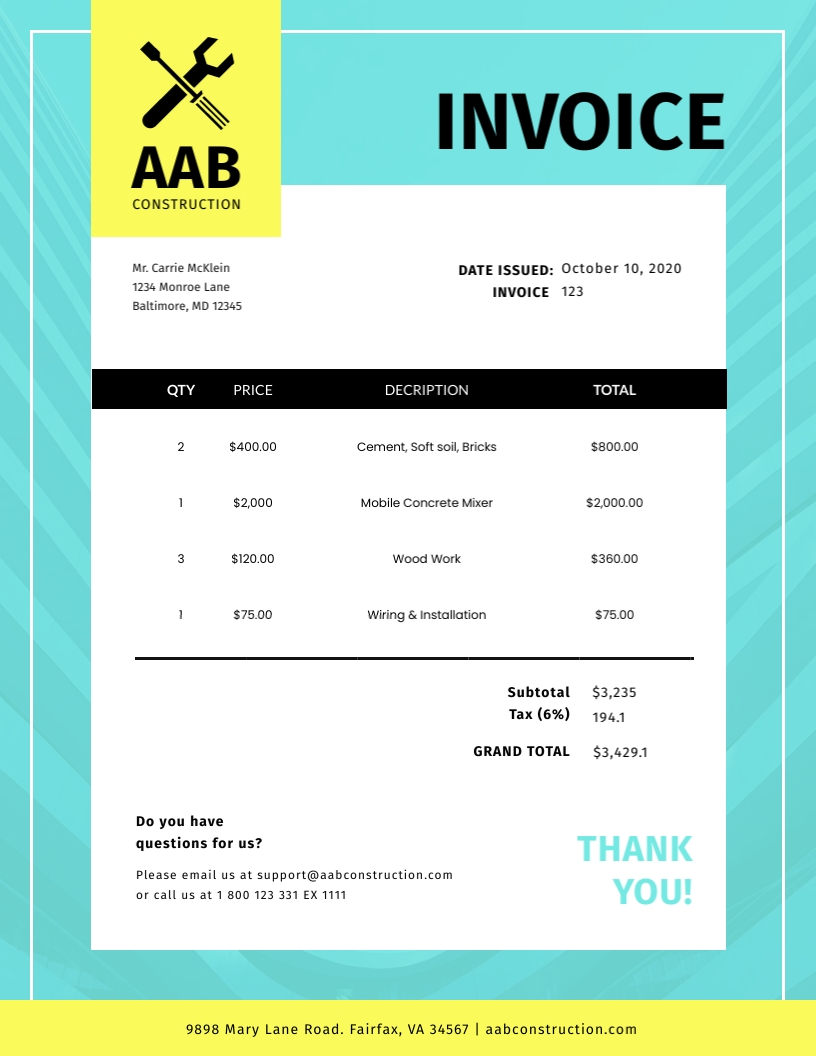
Another crucial invoice information is the name of the document’s recipient. It makes the document more straightforward, helps avoid mistakes, and can be used as proof in case of legal action.
It is common to have numerous invoices regarding the same project, so having just the first piece of information might not be enough to identify which one is the correct form. The client’s name is also featured at the top of the document.
Contractor’s Name
Along with the client's name, it is also essential to highlight the name of the contractor or company responsible for handling the invoice and project. This will help the client ensure the payment goes to the correct person.
Along with the name, the company responsible can add other pieces of information to help with contact and identification, like phone number and email address, for example. The more details you provide, the better it will be for the document and the client paying for it.
Invoice Date
Another key information your document should feature is the date on which the construction invoice template was created. This helps the customer and company to see when the client received the form and how much time they had to make the requested payment.
The date can also be used to locate a specific invoice among all the files you have stored. This helps to organize them and makes this task much quicker.
Invoice Number
Each document should have a unique identification number. Although you have numerous other filter categories that help identify a specific sheet, the invoice number is the main tool for that.
Whether when working with construction invoicing software or a physical data bank, the invoice number will be the easiest way to locate the desired document. This also helps the client to avoid mistakes when paying the invoice. This identification must be unique and clearly visible to anyone accessing the record.
List of Works and Services

The list of items is the core of your construction invoice template. Here you’ll list everything provided to the client, from services to products. You can also list the materials used to complete each project task.
When listing the items, the construction business owner can also assign the hourly rate of each service for a better understanding of each item and the price assigned to them. Some common item examples include building materials and painting services.
Each item must be highlighted to ensure the customer understands what they’re paying for. Better communication will result in invoices being paid faster.
Price of Each Service and Product
Next to each item, you’ll list their individual value. When dealing with products, you can also create an extra field to separate the unit price and the sum of the total units bought.
It is vital to notice that in this field, you’ll only list the item value. Make sure not to include any extra cost, like taxes and other values of this kind.
For a better-looking contractor invoice, you can also sort the items by category. Separate the list by writing all services and then all products instead of using a random order, for example.
Service Description
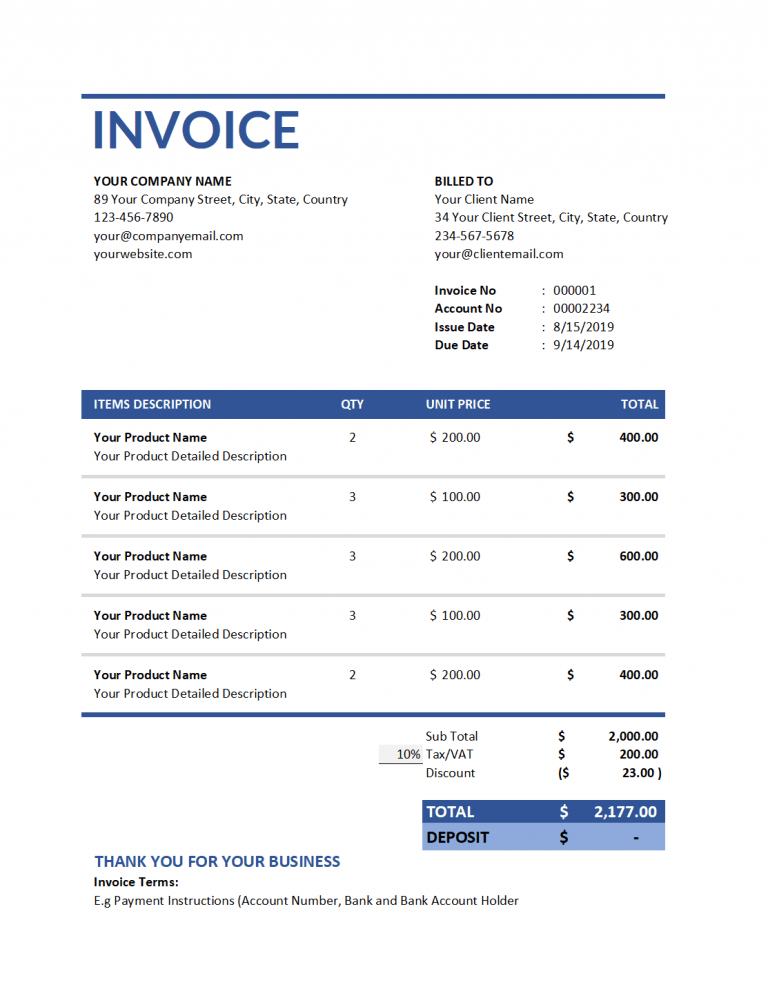
Adding a brief description of each item featured in the list is also highly recommended since it can help clarify in case the customer has any doubts about the item or why they’re being charged.
More complex activities might require extensive descriptions, but in most cases, a simple phrase will be enough to explain the item.
The description is commonly featured right below the item. This way, your client can easily identify which one it regards.
Payment Details
Your invoice should also include a space dedicated to specifying the payment details, like the method used and if the total amount will be paid at once. This helps with invoice tracking and generating invoices automatically, depending on the number of payments that will be made. Moreover, this way, you ensure that your invoice clients agree to and are aware of the payment terms.
Taxes

Almost any construction invoice will feature taxes that the client is required to pay. They can regard different aspects of the project, from legal taxes to any other fee that is not directly related to the services and products provided.
The tax values must be clearly visible to the invoice payer to avoid any confusion regarding the amount being paid and the reasons behind it.
create a dedicated field that clearly highlights and explains each tax value. This way, your documentation will provide those involved with a clear understanding of the total amount being calculated.
Total Amount
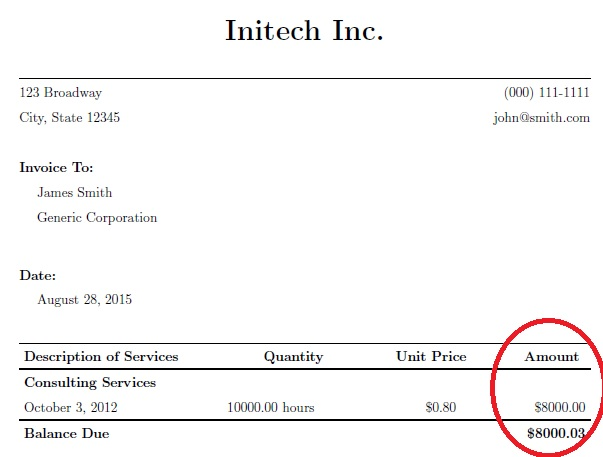
At the bottom of the page, there will be a dedicated field specifically designed to indicate the total amount that your client is required to pay. It will be the sum of all services, products, taxes, and any other value indicated in the form.
Make sure this information is more visible and highlighted than the others to ensure they will not pay the wrong amount, thinking it is total. You don’t need to create extra features for this field. Keep it simple to prevent your customers from making mistakes.
Signature
If you want your document to have legal value, it must have signatures from both the client and the contractor. In the construction industry, this works the same way. The last field of your document will be dedicated to the signatures that must be collected.
With this, you ensure that both parties agree to all terms and conditions stipulated. Depending on the platform being used for the invoice templates, you can add integration for digital signatures.
Platforms to Create Your Invoice Templates
When it comes to the creation of a construction invoice template, there are numerous options available. From known platforms to specialized software, each one has its own tools and features to make the invoicing process easier for your business.
Among all the options available, we highly recommend using Microsoft Word for this task. MS Word not only has the best tools and features on the market but is also an industry standard, meaning that you won’t need extra tools for generating your final invoice template.
If you don’t have a Microsoft Office activation key, you can find one at RoyalCDKeys for a considerably lower price. This way, you can have access to all the tools you need to create and send invoices and still save money.
Free Construction Invoice Template Examples
If you don’t want to create your invoice template from scratch, there is no problem. Here are some free invoice template documents you can download and edit to better fit your needs.
Don’t forget to choose a template that reflects the type of your project and objectives. This way, you ensure the best results out of the form.
Template #1
Printable construction invoice template. A document that can be used both online and physically for sending invoices to your clients.

Template #2
Billing invoice for construction project. Invoice in the bill format with categories designed specifically for the construction industry.
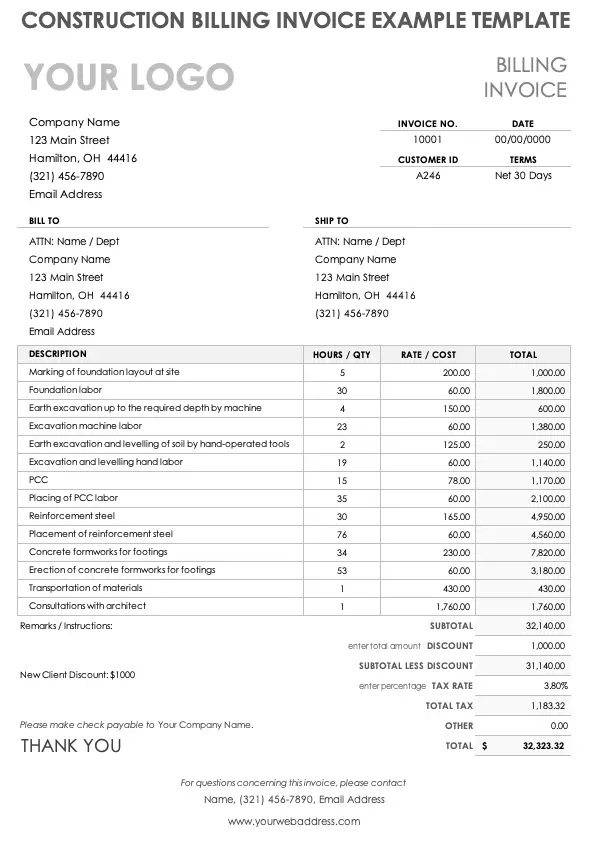
Template #3
Simple construction invoice template. A document containing the main categories necessary for building a complete invoice.
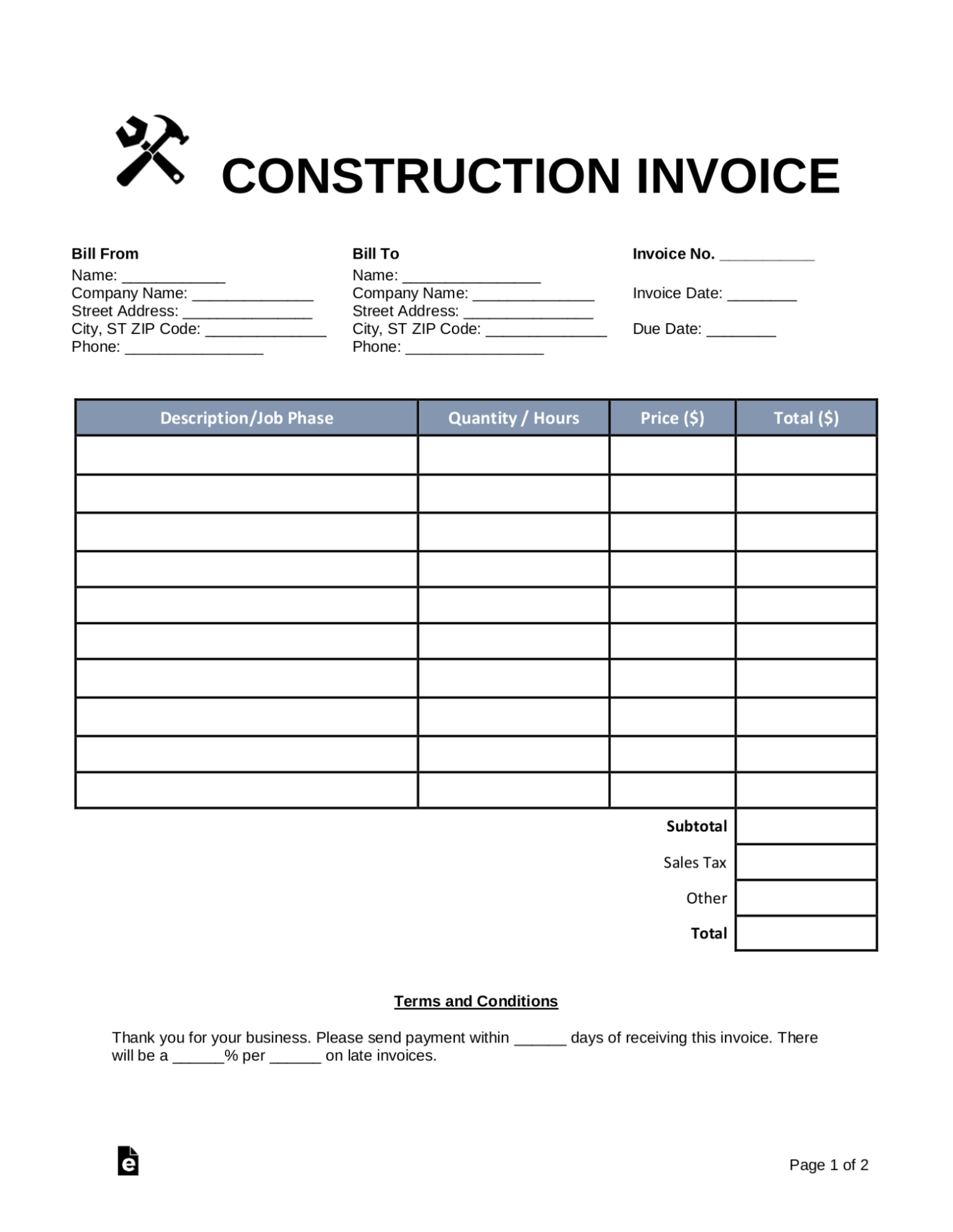
Time to Start Making Your Construction Invoice Templates
Having the proper invoice template can be a game changer for construction managers and any employee responsible for the company's financial sector. With the proper categories, the document ensures that both parties agree on everything and avoids mistakes and problems when it comes to payment.
For the form to work correctly, all categories need to be properly identified and well-structured in the document, from the payment instructions to the applicable taxes featured in the final value. Make sure to analyze every aspect of the template to achieve the desired results.
Now that you know everything you need, it is time to start creating invoices for your construction work. Follow the invoicing tips above, and you’ll end up with a tool that positively impacts all aspects of business finances.












